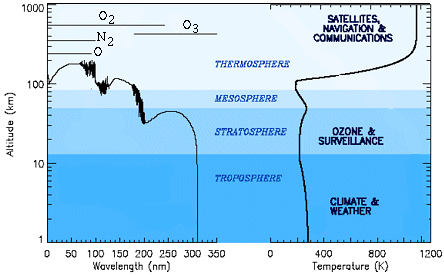Comparing Venus and Earth From the outside in..
 The structure of Earth's atmosphere.
The structure of Earth's atmosphere.
Clouds extend to the top of the troposphere,
about 10-11 miles up. Despite the diagram,
typical planes fly in the troposphere, up to
7 miles above the ground. Above
that is the stratosphere, famous for its ozone.
This is also where the atmosphere becomes dense enough
that entering meteors heat up and glow.
Above the Mesosphere, at 200 or so miles, is where the
Space Shuttle flies.

|
| The lower thermosphere (very hot) and mesosphere is where X-rays are absorbed. UV light is absorbed in the the stratosphere. The optical ( >350 nm) easily gets to the ground. Optical light most efficiently and safely warms the Earth's surface. |
The structure of Venus' atmosphere
Clouds form at the top of the Venusian troposphere, just like
on Earth and at the same Temp (around freezing temperatures)
and pressure, only at 60 km above the surface.
The closer to the surface, the hotter it gets.
The Venusian clouds are made up of sulfuric
acid droplets and they zip around the planet at
100 m/s! The total mass of cloud material
is not great, it would form a liquid layer of only 0.1 mm
thick on the surface. However, these clouds are effective
at blocking much of the Sun's light from getting to
the surface.. So why does it get so hot?